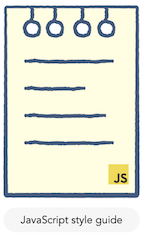Trusted answers to developer questions
JavaScript style guide
When you follow the style guidelines for a language that you are working with, the code becomes more readable and maintainable.
Let’s go over some guidelines for Javascript from the Google JavaScript Style Guide:
Naming conventions
- Class, record, interface, and typedef names are written in UpperCamelCase.
- Method names are written in lowerCamelCase.
- Parameter names are written in lowerCamelCase.
- Local variable names are written in lowerCamelCase.
- Constants are written in UPPERCASE.
// class name in UpperCamelCase
class MyClass {
// Class methods in lowerCamelCase
constructor() { ... }
// Parameters in lowerCamelCase
methodOne(numberOne) { ... }
}
// Local variable name in lowerCamelCase
let myVariable = 20;
// Constant in UPPERCASE
const PI = 3.142;
Formatting
- Control structures (e.g., if, for, while, etc.) are surrounded by braces.
- Spaces are used around operators (e.g., +, -) and after commas.
- There is no line break before the opening brace, but there is a line break after the opening brace and a line break before the closing brace.
- Each time a new block or block-like construct is opened, indent it with two spaces.
- Each statement is followed by a line-break.
- Every statement must be terminated with a semicolon.
- Lines should be no longer than 80 characters.
// Braces around the control structure for.
// Spaces around the operators
// Line break after the opening and closing curly brace
for(int i = 0; i < 10; i++){
// Statement indented by two spaces.
console.log("Hello World!");
}
Object literals
- Object literals (comma-separated key-value pairs ) may represent either structs (with unquoted keys and/or symbols) or dicts (with quoted keys). Mixing these two in a single object is invalid.
- Use an object literal,
{ }, instead of the object constructor.
// Using the { } object literal
let country = {
// Using unquoted keys only
Name: "Singapore",
Area: 721.5,
};
Variable declarations
- Use
letwhen a variable needs to be reassigned andconstotherwise. Do not usevar. - Every variable declaration declares only one variable.
// Using let because myVar needs to be reassigned late
// Moreover, only one variable is declared per line
let myVar = 10;
let anotherVar = 19;
myVar = 20;
// Using const because welcome does not need to reassigned.
const welcome = "Hello";
Refer to the Google JavaScript Style Guide for more details.
RELATED TAGS
javascript
style guide
Copyright ©2024 Educative, Inc. All rights reserved
TRENDING TOPICS
Did you find this helpful?
